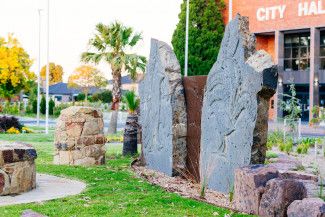A ceremonial fire pit and symbolic sculpture has been unveiled in the heart of Springvale.
The firepit, titled ‘Waa and Bulln Bulln Corroboree” is an important focal point of the Springvale Community Hub, and will be used for permitted events and ceremonies.
Mayor of the City of Greater Dandenong, Cr Angela Long, said "the artwork is a significant symbol of Council’s commitment to recognise the Traditional Owners of the land where the municipality sits".
“The importance of heritage and Culture is central to who we are. There are many facets of this beautiful space that pay tribute to the history of Springvale, dating back to the nation’s First People. This magnificent artwork will be enjoyed by many generations in a space that encourages people of all ages, backgrounds and interests to come together,” Cr Long said.
Artists Fiona Clarke and Ken McKean created the artwork in collaboration with Bunurong and Wurundjeri Land Councils.
The artists’ interpretation includes a symbolic sculpture comprising of two large bluestones. A lyre bird (Bulln Bulln) and crow (Waa) have been hand carved into the stone symbolising the two local Aboriginal groups, the Wurundjeri and Bunurong of the Kulin nation. As night falls, the carvings glow and reflect the night sky above.
The bluestone rock symbolises Aboriginal people’s connection to the earth and references them as the oldest living Culture in the world.
Between Waa and Bulln Bulln is a sheet of steel symbolising the connection between the Wurundjeri and Bunurong peoples and the strength of their Culture.
A mixing bowl has been placed near the fire pit to invite attendees to join in Ceremony by rubbing ochre onto their faces. Seating has been made from locally grown reclaimed river red gums, and a native cherry ballart sapling will be planted on the site. Leaves from the cherry ballart will be used to create the atmospheric smoke used in Welcome to Country and cleansing ceremonies.
Cr Long said "the artwork is a feature of many significant pieces across the municipality. Council works with many First Nation’s artists on a number of projects across Greater Dandenong, and this work at Springvale Community Hub is a real highlight amongst the many pieces featured in the region.”
Artwork Narratives
This artwork symbolically represents the coming together of Bunurong People and Wurundjeri People to celebrate this beautiful part of Bunurong Country. Waa (the crow) symbolises the Wurundjeri Woi Wurrung peoples and Bulln Bulln (the Lyrebird) symbolises the Bunurong people.
Fiona and ken have etched Waa and Bulln Bulln into bluestone which resembles the shape of a traditional possum skin cloak, of great significance to aboriginal peoples of South East Victoria. Around 50 to 90 possum skins were gathered and dreid out for over 12 months then sewn together with the sinews from a kangaroos tail. They were worn by Aboriginal clan members especially when the warm seasons began to fade. The bluestone rock symbolised Aboriginal people’s connection to the earth and references them as the oldest living culture in the world. The rock on which Melbourne and surrounds stands, Castlemaine Slate, is around 450 million years old and has been used to create the base of the fire pit. Between Waa and Bulln Bulln is a sheet of steel symbolising the connection between the Wurundjeri and Bunurong peoples and the strength of their culture.
Sitting in front of the sculpture will be a fire pit made from Castlemaine slate. Around it will be the aboriginal symbol for running water paved also in Castlemaine Slate. Nearby the fire pit is the mixing bowl. During special ceremonies it has become almost traditional to invite and welcome attendees to join the ceremony by rubbing ochre onto their faces.
Seating has been made from locally grown reclaimed river red gums. They have been used by Aboriginal people traditionally for making canoes, bowls, shields, and other utensils. The wood is red is because it contains very high levels of chemicals such as polyphenols, which are a natural antibiotic when combined with air. The chemicals protect the living tree from disease and some pest attacks and were used by Aboriginal people for medicine.
Surrounding the site is Kangaroo grass and Australian Grass trees. Evidence suggests Aboriginal people have been grinding the seeds of kangaroo grass to make flour for cooking for more than 30,000 years. The flour was used to make damper, which is said to have a nutty flavour, while the seeds are also said to taste like fresh green peas. Grass trees are similarly important in Aboriginal culture. They provided food, drink, fibre and materials for making implements and weapons. The leaves produce a hard, waterproof resin, which could be collected from the base of the trunk. The resin was a valuable trading item and was traded amongst different mobs. The light straight flower stalk served as a butt-piece for spears and the nectar from the flower could be extracted by soaking it in water filled bark troughs, to produce a thick sweet drink, amongst other multiple uses. Today, grass trees have become rare in their natural environment because of land clearing and land degradation.
The Lyrebird is named for its ability to mimic sounds. From the calls of other birds to motorbikes and chainsaws, they create songs that reflect their local environment. Many Aboriginal stories speak of the lyrebird as being gifted this talent to talk to all other creatures. Fossils of Lyrebird ancestors have been discovered up to 15 million years BP (before present). This makes Australian songbirds as the oldest in the world. Recent research has also discovered that the Lyrebird, with its long legs and big feet, turns over 200 tonnes of earth per hectare, per year, effectively composting the forest floor’s leaf litter, which in turn reduces the fire-load. Meaning they help reduce the risk of bush fires.
Waa is the Ancestral Crow, the protector. We understand Waa to be the protector of waterways and a trickster. One Dreamtime story has Waa bring fire to mankind consider changing to ‘the people’. Mankind is an outdated term. In the Dreamtime, fire had been a jealously-guarded secret of the seven Karatgurk women who lived by the Yarra River. These women carried live coals on the ends of their digging sticks, allowing them to cook yams. One day Waa, the white crow, found a cooked yam and, finding it more delicious than raw vegetables he decided he would trick the Karatgurk women to hand over fire to him. Waa hid snakes in an ant mound and told the women the larvae inside were more delicious than yams. As they poked their digging sticks into the mound, the snakes attacked. To protect themselves, they struck at the snakes with such force that the coals flew off the ends of their digging sticks. We have a slightly different story for this.
Waa stole the coals and quickly flew up high into a tree where the women couldn’t reach him. Waa later shared his coals with Bunjil the Eaglehawke, however, a large crowd appeared demanding he share the secret of fire with all of them. In fright, Waa flung the coals at the crowd which set alight the bush below and created a bushfire. The fire swept through the land and turned Waa’s feathers black. It nearly engulfed the whole land until Bunjil stopped it. The Karatgurk women were swept into the sky in the bushfire and where they became the Pleiades, the stars. Their glowing digging sticks became the stars.


